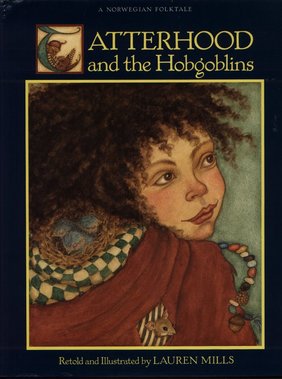|
First I have to thank the lovely Kristin from Tales of Faerie for hosting my guest post on her blog. She writes about a lot of different fairytales and it's a great read. This is kind of weird, because I've done so much research on thumbling tales, but my favorite fairytale is actually Tatterhood. There is a comic adaptation that I heartily recommend, and a very funny analysis by Ursula Vernon. To make a long story short: a queen longs to have a child, and eventually meets a wise woman who tells her to grow a magical flower and eat it. However, she is not to eat the weed that grows with it. Predictably, the queen eats the weed and gives birth to two daughters. One is the classic beautiful princess, and the other - Tatterhood - is unkempt and noisy. She comes out of the womb riding a goat and waving a spoon. I'd pay good money to see an adaptation where someone actually goes into the implications of a woman giving birth to two girls, a goat, and a spoon. The two sisters are the best of friends, but when trolls attack and Tatterhood is busy fending them off with her battle spoon, a troll steals the beautiful princess's head and replaces it with a cow's. Cue an adventure to retrieve the right head. At the end, the sisters marry a king and a prince, respectively, and Tatterhood reveals her . . . magic powers? There are so many questions raised by this story. There's even an adopted princess running around who's only mentioned in the prologue of the story. Seriously, what happened to her? This post is kind of a counterpart to the theme of death and food, as well as building off Nang Ut and the Miraculous Birth. Here we have life and food! Like Tatterhood, many, many fairytales begin with infertility, and in many, many fairytales a woman is able to have a child after, say, an old beggar gives her something to eat. This is Aarne-Thompson Motif T511 and comes with a whole host of variations - eating fruit, flowers, fish, you name it. In Tatterhood, the queen eats a rose and a weed. In Prince Lindworm, the queen eats a pair of roses. In the Snow Daughter and the Fire Son, a woman swallows an icicle and a spark. (That one ended badly, but I like the first half of the story.) In Ivan the Cow's Son, the fateful meal is a fish (which is eaten by a queen, a servant, and a cow, who all bear identical sons - this story raises all kinds of questions.) Food is often a symbol for desire or temptation. In some, like Nang Ut, the food is the means of contact between the mother and father. However, in many instances of T511, the father almost seems like a sidenote. The mother wants a child and she gets one with or without him, often through the intervention of another female character like the beggar woman in Tatterhood. Some versions skip the pregnancy and have a child directly born from a fruit or flower - like Thumbelina, who has no father figure whatsoever. On a slightly different twist, sometimes the food is a means of rebirth In Welsh myth, Gwion flees Cerridwen in a transformation sequence, finally becoming a grain of wheat, which she devours. This causes her to become pregnant and give birth to him as her son, Taliesin. In a Cahto Indian tale from California, as part of a Prometheus-style ploy to win light, Raven becomes a speck of dirt in some drinking water. The girl who swallows it becomes pregnant and, as her son, he is able to gain access to the hoarded light. It's especially interesting that almost invariably, the mother messes up and is punished with a monstrous or deformed child. This is another dimension to food as a symbol for desire and temptation - the mother gives in to curiosity or greed and crosses a line. "But the pretty flower tasted so sweet, that she couldn't help herself. She ate the other up too, for, she thought, 'it can't hurt or help one much either way, I'll be bound.'" Tatterhood's mother disobeys the rules and eats the weed and rose together. Prince Lindworm's mother behaves similarly. In India, Der Angule's mother eats the goddess-given cucumber right away instead of waiting as instructed, and Bitaram's mother eats a certain fruit even after hearing what the consequences will be. Tales like Nciç and Mkidech from North Africa and the Middle East often begin with a king who has many wives but no sons. They eat magical apples or pomegranates, and each bears a child; however, the youngest wife only receives half of a fruit, and so her son is stunted in growth. But in the end, these stories of falling to temptation still tend to work out. Tatterhood's birth seems disastrous at first, but she saves her sister. While the hero may seem unimpressive or upsetting at first glance, they ultimately pull through with a happy ending and become a blessing to their parents, even if they eat a few people along the way. (I'm looking at you, Prince Lindworm.) SOURCES
Text copyright © Writing in Margins, All Rights Reserved
2 Comments
|
About
Researching folktales and fairies, with a focus on common tale types. Archives
July 2024
Categories
All
|
Writing in Margins



 RSS Feed
RSS Feed
